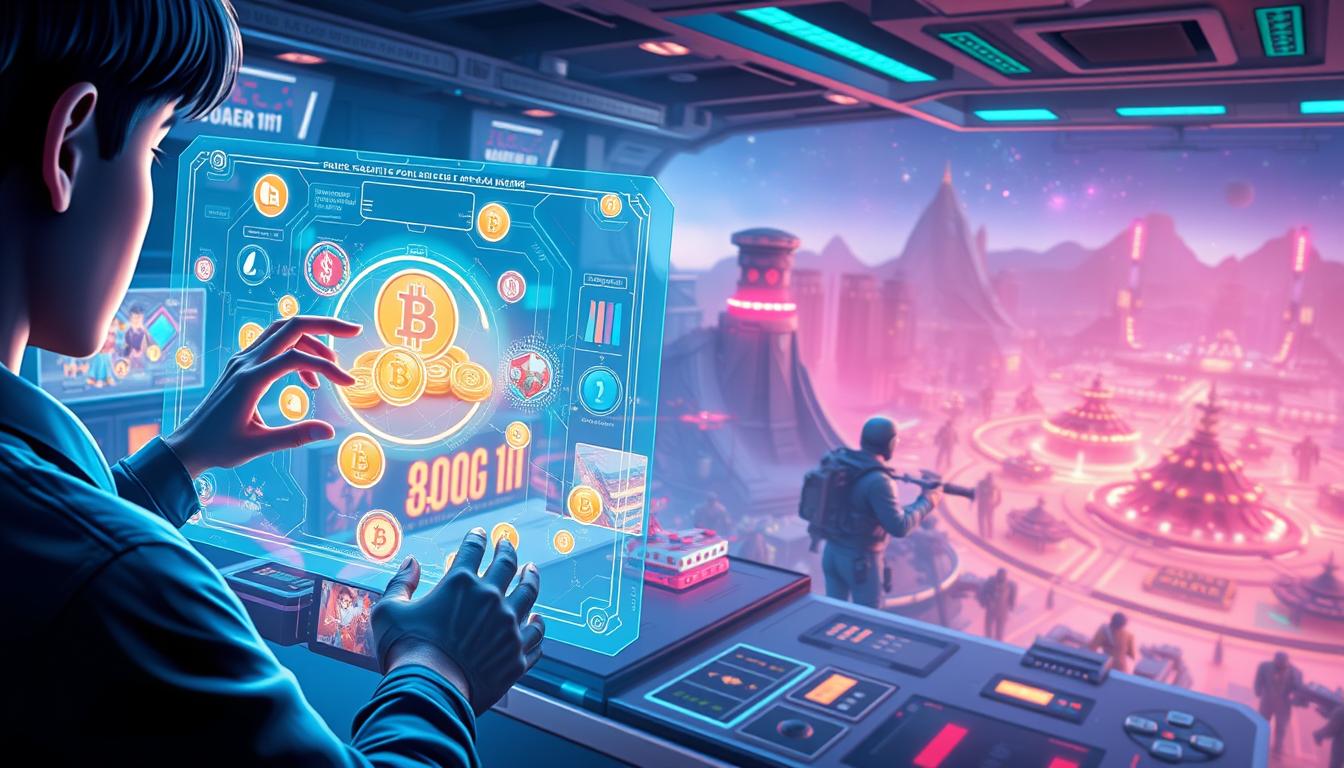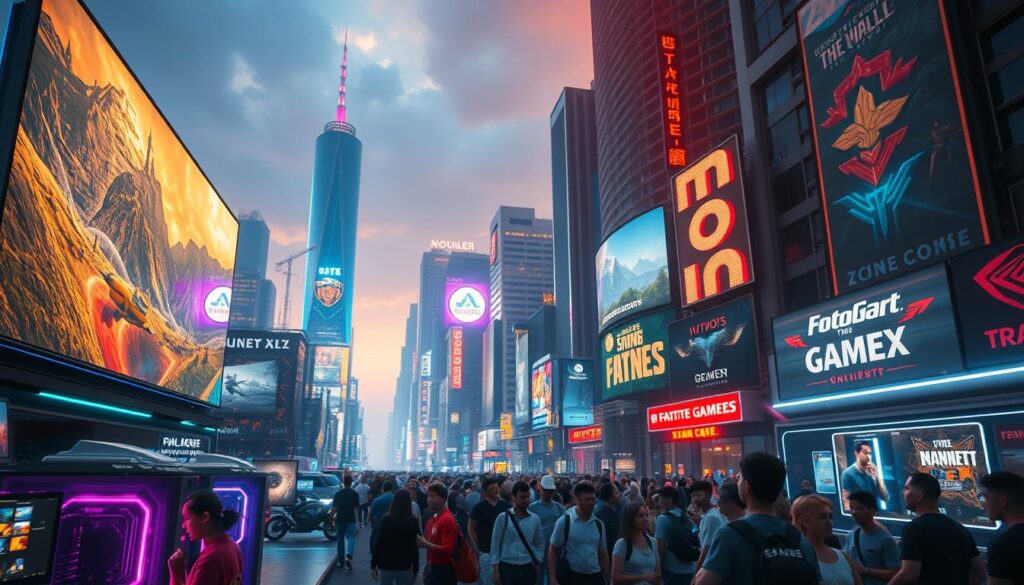The gaming industry is undergoing a significant transformation, thanks to the integration of blockchain technology. This innovation is revolutionizing in-game economies, allowing for more secure, transparent, and player-centric experiences.
With the rise of blockchain gaming, players can now truly own their digital assets, such as characters, items, and currencies. This shift is made possible by the use of cryptocurrency and non-fungible tokens (NFTs), which provide a secure and decentralized way to manage in-game transactions.
The impact of blockchain on in-game economies is profound, enabling new revenue streams for game developers and creating more engaging experiences for players.
Key Takeaways
- The integration of blockchain technology is transforming the gaming industry.
- Blockchain gaming enables players to truly own their digital assets.
- Cryptocurrency and NFTs provide a secure way to manage in-game transactions.
- The use of blockchain creates new revenue streams for game developers.
- Blockchain-based in-game economies offer more engaging experiences for players.
Understanding Blockchain Technology in Gaming
Blockchain technology is revolutionizing the gaming industry by providing a secure and transparent way to manage in-game economies. This innovation is rooted in the fundamental principles of blockchain, which enable the creation of decentralized, tamper-proof systems.
What is Blockchain Technology?
At its core, blockchain technology relies on a distributed ledger that records transactions across a network of computers. This decentralized approach ensures that data is not controlled by a single entity, enhancing security and transparency.
Distributed Ledger Fundamentals
A distributed ledger is a database that is consensually shared and synchronized across the network. It allows for the recording of transactions and provides a permanent, unalterable record.
Smart Contracts Explained
Smart contracts are self-executing contracts with the terms of the agreement written directly into lines of code. They automate processes and ensure that transactions are carried out as intended, without the need for intermediaries.
Key Features of Blockchain Relevant to Gaming
Blockchain technology offers several key features that are particularly relevant to the gaming industry, including immutability and security, as well as the benefits of decentralization.
Immutability and Security
The immutability of blockchain ensures that once a transaction is recorded, it cannot be altered. This provides a high level of security, protecting against fraud and cyber attacks.
Decentralization Benefits
Decentralization allows for greater player control and flexibility, as assets and transactions are managed on a public ledger that is not controlled by a single entity. This fosters a more open and equitable gaming environment.
Traditional In-Game Economies: Limitations and Challenges
Despite their popularity, traditional in-game economies are marred by centralized control and ownership issues. These economies, which have been the backbone of the gaming industry, face several challenges that affect both players and developers.
Centralized Control and Its Drawbacks
Traditional in-game economies are typically controlled by the game developers or publishers. This centralized control can lead to limitations in how players can interact with the game’s economy. For instance, players may not have the freedom to buy, sell, or trade assets as they wish.
Issues with Virtual Asset Ownership
In traditional gaming economies, players do not truly own their virtual assets. Instead, they have a license to use these assets as per the game’s End User License Agreement (EULA). This lack of true ownership can be frustrating for players who invest significant time and money into acquiring virtual items.
Problems with Value Transfer Between Games
Another significant issue is the inability to transfer value between different games. This limitation means that assets acquired in one game cannot be used or sold in another, creating a walled garden effect.
Publisher-Dominated Monetization Models
Traditional in-game economies often rely on monetization models that favor the publishers. These models, such as loot boxes and microtransactions, can lead to exploitative practices that prioritize profit over player experience.
| Limitation | Description | Impact |
|---|---|---|
| Centralized Control | Game economies controlled by developers/publishers | Limited player freedom |
| Lack of True Ownership | Players don’t own virtual assets | Frustration, lack of investment incentive |
| Limited Value Transfer | Assets can’t be transferred between games | Walled garden effect, limited asset utility |
| Publisher-Dominated Monetization | Monetization models favoring publishers | Exploitative practices, poor player experience |
How Blockchain Is Powering In-Game Economies
In-game economies are being redefined by the power of blockchain technology. This revolutionary shift is enabling new ways for players to interact with games and for developers to create more engaging experiences.
Decentralization of Game Assets
Blockchain technology allows for the decentralization of game assets, giving players more control over their virtual items. This decentralization means that assets are not stored in a single location but are instead distributed across a network, making them more secure and less susceptible to manipulation.
True Ownership of Virtual Items
With blockchain, players have true ownership of virtual items. This is achieved through the use of non-fungible tokens (NFTs) that represent unique digital assets. Players can buy, sell, and trade these assets freely, and ownership is securely recorded on the blockchain.
Transparent and Secure Transactions
Blockchain technology facilitates transparent and secure transactions within games. All transactions are recorded on a public ledger, ensuring that they are tamper-proof and transparent. This transparency builds trust among players and creates a more reliable in-game economy.
Player-Driven Marketplaces
The integration of blockchain enables the creation of player-driven marketplaces where players can buy, sell, and trade digital assets without the need for intermediaries. This not only enhances the gaming experience but also opens up new economic opportunities for players.
The benefits of blockchain in gaming are clear: it decentralizes game assets, provides true ownership of virtual items, ensures transparent and secure transactions, and fosters player-driven marketplaces. As the technology continues to evolve, we can expect to see even more innovative applications in the gaming industry.
- Decentralized game assets enhance security and player control.
- True ownership of virtual items through NFTs.
- Transparent and secure transactions recorded on the blockchain.
- Player-driven marketplaces create new economic opportunities.
Non-Fungible Tokens (NFTs) in Gaming
The integration of Non-Fungible Tokens (NFTs) is revolutionizing the gaming industry by providing unique digital ownership experiences. NFTs have emerged as a crucial element in gaming, enabling players to own, trade, and utilize unique digital assets.
What Are NFTs and How Do They Work?
NFTs are digital assets that represent ownership of unique items, such as art, collectibles, or in-game items. They are stored on a blockchain, ensuring their scarcity and authenticity. Unlike fungible tokens, NFTs are not interchangeable, making each one unique.
NFT Implementation in Games
NFTs are being implemented in various ways across different games, enhancing player engagement and ownership. This includes:
Character and Avatar NFTs
Players can own unique characters or avatars, which can be traded or used within the game. These NFTs often come with specific attributes or abilities, adding a new layer of strategy to gameplay.
Land and Property NFTs
Some games allow players to own virtual land or property, represented as NFTs. This can provide players with a sense of ownership and the ability to develop or trade these assets.
Weapon and Item NFTs
NFTs can also represent unique weapons or items within a game, offering players exclusive content that can be used or traded. This enhances the gaming experience by providing rare or limited-edition items.
Popular NFT Gaming Projects
Several gaming projects have successfully integrated NFTs, showcasing their potential. Examples include games that allow players to collect, trade, and battle unique digital creatures or characters, with ownership verified on the blockchain.
The use of NFTs in gaming is expanding, with more developers exploring the possibilities of unique digital ownership. As the technology evolves, we can expect to see even more innovative applications of NFTs in the gaming industry.
Play-to-Earn: The New Gaming Paradigm
Blockchain technology has given rise to play-to-earn gaming, a paradigm that is changing how gamers interact with virtual economies. This new model is not just a trend but a significant shift in how games are designed, played, and monetized.
How Play-to-Earn Models Work
Play-to-earn models allow players to earn cryptocurrency or digital assets by playing games. These models are built on blockchain technology, ensuring that transactions are secure, transparent, and tamper-proof. Players can then trade these assets on online marketplaces, converting their gaming achievements into real-world value.
Economic Opportunities for Players
The play-to-earn model presents numerous economic opportunities for players. It enables them to:
- Earn a full-time income through gaming
- Supplement their existing income
Full-time Gaming Careers
For some, play-to-earn has become a viable career path. Skilled gamers can earn substantial amounts, rivaling traditional employment incomes.
Supplemental Income Strategies
Others use play-to-earn as a way to supplement their income. This can be particularly beneficial in regions with high living costs or economic instability.
Case Studies: Axie Infinity and StepN
Axie Infinity and StepN are two prominent examples of successful play-to-earn games. Axie Infinity allows players to collect, breed, and battle creatures known as Axies, while StepN rewards players with cryptocurrency for walking or running.
| Game | Primary Activity | Reward |
|---|---|---|
| Axie Infinity | Battling and Breeding Axies | Cryptocurrency |
| StepN | Walking or Running | Cryptocurrency |
Socioeconomic Impact in Developing Countries
The play-to-earn model has had a significant socioeconomic impact, particularly in developing countries. It has provided new economic opportunities, helping to alleviate poverty and improve living standards.
“Play-to-earn has the potential to revolutionize the way we think about work and income, especially in regions where traditional employment opportunities are scarce.”
As the play-to-earn ecosystem continues to evolve, it’s likely to have a lasting impact on the gaming industry and beyond.
Cryptocurrency Integration in Gaming Platforms
The integration of cryptocurrency is revolutionizing the gaming industry by introducing new financial models and enhancing player engagement. This shift is primarily driven by the need for more secure, transparent, and player-centric economies within games.
In-Game Tokens and Currencies
Gaming platforms are now utilizing in-game tokens and currencies that are based on blockchain technology. These tokens can be used for various in-game transactions, providing a seamless experience for players. The use of cryptocurrency eliminates the need for traditional payment systems, reducing transaction costs and increasing the speed of transactions.

Cross-Platform Value Exchange
One of the significant advantages of integrating cryptocurrency in gaming is the ability to facilitate cross-platform value exchange. Players can now transfer their assets or currencies between different games or platforms, enhancing the overall gaming experience and providing more flexibility.
Staking and Rewards Systems
Cryptocurrency enables the implementation of staking and rewards systems within games. Players can stake their tokens to participate in governance or earn rewards, adding a new layer of engagement and investment in the game’s ecosystem.
DeFi Elements in Gaming
The incorporation of DeFi elements in gaming allows for more complex financial interactions within game worlds. Players can lend, borrow, or provide liquidity to earn interest on their in-game assets, mirroring real-world financial systems.
Impact on Game Developers and Publishers
The integration of blockchain technology is revolutionizing the gaming industry, presenting new opportunities and challenges for game developers and publishers. This shift is not just about technology; it’s about creating a more engaged player base and opening up new revenue streams.
New Revenue Models
Blockchain introduces play-to-earn models, allowing players to earn cryptocurrency or NFTs that have real-world value. This model creates new revenue streams for developers through transaction fees and NFT sales.
- In-game asset marketplaces
- NFT sales and trading
- Transaction fees on blockchain
Changing Relationship with Players
Blockchain enables a more transparent and player-centric economy. Developers can build stronger relationships with players by giving them true ownership of in-game assets and a say in game development through decentralized governance.
Indie Developer Opportunities
Blockchain technology lowers the barrier to entry for indie developers. With blockchain, indie games can gain more visibility and funding through token sales and community support.
Traditional Publishers’ Adaptation Strategies
Traditional publishers are adapting by either integrating blockchain technology into their existing games or investing in blockchain-based gaming projects. They are also exploring new business models that incorporate blockchain’s unique features.
By embracing blockchain, game developers and publishers can unlock new opportunities, enhance player engagement, and stay competitive in a rapidly evolving gaming landscape.
Successful Blockchain Games and Platforms
The blockchain gaming industry has seen significant growth with the emergence of innovative platforms. These platforms are not only enhancing the gaming experience but also providing new economic opportunities for players.

Decentraland and Virtual Real Estate
Decentraland is a virtual reality platform that allows users to create, experience, and monetize content and applications. It has gained popularity for its virtual real estate concept, where users can buy, sell, and own digital land.
The Sandbox and User-Generated Content
The Sandbox is another prominent blockchain-based virtual world where players can create, sell, and own digital assets. It empowers creators by allowing them to monetize their gaming experiences and assets.
Gods Unchained and Digital Card Ownership
Gods Unchained is a blockchain-based trading card game that allows players to truly own their digital cards. The game has gained a significant following due to its play-to-earn model and the ability to trade cards on various marketplaces.
Illuvium and AAA-Quality Blockchain Gaming
Illuvium is an upcoming blockchain game that promises to deliver AAA-quality graphics and gameplay. It aims to set a new standard for blockchain gaming with its immersive and interactive universe.
Gala Games Ecosystem
Gala Games is a blockchain gaming platform that focuses on creating a decentralized gaming ecosystem. It allows players to have control over their gaming experience and rewards them with tokens for their participation.
These examples demonstrate the diversity and potential of blockchain gaming, offering unique experiences and opportunities for players worldwide.
Challenges and Limitations of Blockchain Gaming
As blockchain gaming continues to evolve, it must overcome several limitations to achieve mainstream success. While the technology offers numerous benefits, including decentralization and true ownership of virtual items, it also faces significant hurdles.
Scalability Issues
One of the primary challenges is scalability. Blockchain technology is still in its early stages, and many networks struggle to handle the high transaction volumes required by popular games. This can lead to congestion, slow transaction times, and increased fees.
Environmental Concerns
Another significant issue is the environmental impact of blockchain gaming. The energy consumption required for mining and transaction validation can be substantial, contributing to carbon emissions and environmental degradation.
Regulatory Uncertainties
The regulatory landscape for blockchain gaming is still evolving and often unclear. This uncertainty can make it difficult for developers to navigate the legal requirements and ensure compliance.
User Experience Barriers
Blockchain gaming also presents user experience challenges. The complexity of blockchain technology can be a barrier to entry for many players, and the need to manage digital wallets and cryptocurrencies can be daunting.
Market Volatility Risks
Finally, blockchain gaming is exposed to market volatility risks. The value of in-game assets and cryptocurrencies can fluctuate rapidly, affecting the overall gaming experience and the value of players’ investments.
Despite these challenges, the blockchain gaming industry is actively working to address these limitations. As the technology continues to mature, we can expect to see significant improvements in scalability, sustainability, and user experience.
Conclusion
As we’ve explored throughout this article, blockchain technology is revolutionizing in-game economies, offering players true ownership of virtual assets and creating new economic opportunities. The integration of blockchain, NFTs, and play-to-earn models is transforming the gaming industry, providing a more immersive and rewarding experience for players.
The future of blockchain gaming looks promising, with the potential for further decentralization, enhanced security, and increased player engagement. As the technology continues to evolve, we can expect to see more innovative applications of blockchain in gaming, driving growth and adoption in the industry.
With major players like Decentraland, The Sandbox, and Axie Infinity leading the way, the blockchain gaming future is bright. As the industry continues to mature, it’s likely that we’ll see a shift towards more player-centric models, where players have greater control over their in-game assets and experiences.
In conclusion, blockchain technology is poised to have a lasting impact on the gaming industry, enabling new revenue streams, enhancing player experiences, and creating a more equitable and transparent gaming ecosystem.
FAQ
What is blockchain technology and how does it relate to gaming?
Blockchain technology is a decentralized, digital ledger that records transactions across a network of computers. In gaming, it enables secure, transparent, and tamper-proof transactions, allowing for true ownership of virtual assets and the creation of player-driven marketplaces.
How do Non-Fungible Tokens (NFTs) work in gaming?
NFTs are unique digital assets that represent ownership of a particular item or character. In gaming, NFTs can be used to create unique digital characters, items, or land, and can be bought, sold, or traded on online marketplaces.
What is the play-to-earn model and how does it work?
The play-to-earn model is a new paradigm in gaming where players can earn cryptocurrency or other rewards by playing games. This model is enabled by blockchain technology and allows players to monetize their gaming experience.
How is blockchain technology being used in games like Axie Infinity and StepN?
Games like Axie Infinity and StepN are using blockchain technology to enable play-to-earn models, allowing players to earn cryptocurrency by playing the game. These games also utilize NFTs to represent unique digital assets.
What are the benefits of using blockchain technology in gaming?
The benefits of using blockchain technology in gaming include decentralization, true ownership of virtual assets, transparent and secure transactions, and the creation of player-driven marketplaces.
What are some of the challenges and limitations of blockchain gaming?
Some of the challenges and limitations of blockchain gaming include scalability issues, environmental concerns, regulatory uncertainties, user experience barriers, and market volatility risks.
How is cryptocurrency being integrated into gaming platforms?
Cryptocurrency is being integrated into gaming platforms through the use of in-game tokens and currencies, cross-platform value exchange, staking and rewards systems, and DeFi elements.
What is the impact of blockchain technology on game developers and publishers?
The impact of blockchain technology on game developers and publishers includes new revenue models, changing dynamics with players, opportunities for indie developers, and strategies for traditional publishers to adapt to the changing landscape.




